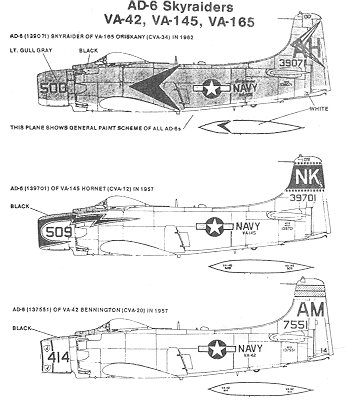|
Sheet # |
Superscale
72-529 for AD-6 Skyraider |
|
Price: |
$6 |
|
Units: |
See Review |
|
Review By: |
Scott Van Aken |
|
Notes: |
|
 Toward the end of WWII, the Navy department was
looking for an aircraft that would be able to carry a prodigious amount of
ordnance. Anything from torpedoes, to mines, to various kinds of bombs or
rockets. To meet that requirement, Douglas developed what would eventually
become the AD-1 Skyraider, the BT2D. To be able to carry all that ordnance meant
that you needed a fairly large aircraft with a powerful engine, so the 2500
horsepower Wright 3350-42 was chosen. Since jets were barely able to keep
themselves in the air, much less carry a lot of bombs, a piston powered aircraft
was the only choice. It also had to be small enough to fit on board the
present aircraft carriers.
Toward the end of WWII, the Navy department was
looking for an aircraft that would be able to carry a prodigious amount of
ordnance. Anything from torpedoes, to mines, to various kinds of bombs or
rockets. To meet that requirement, Douglas developed what would eventually
become the AD-1 Skyraider, the BT2D. To be able to carry all that ordnance meant
that you needed a fairly large aircraft with a powerful engine, so the 2500
horsepower Wright 3350-42 was chosen. Since jets were barely able to keep
themselves in the air, much less carry a lot of bombs, a piston powered aircraft
was the only choice. It also had to be small enough to fit on board the
present aircraft carriers.
Designed as an
attack aircraft and not as a fighter, it wasn't really necessary that it be
fast. Nor particularly aerodynamic. On 18 March 1945, the first of a long line
of Skyraiders took to the air. And the rest, as they say, is history. There
began a long association with the US Navy that did not end until the late 1960s.
It was also used by the USAF, the British, the French and a number of other air
forces around the world. The Skyraider was an adaptable platform and eventually
became an early warning and electronic surveillance aircraft as well as an
attack bomber. Even today, there are a number of Skyraiders still flying as
warbirds.
Superscale's sheet
covers three of the later versions, the AD-6. Fortunately, there are a number of
kits available for this version in 1/72 scale. Fujimi,  Tsukuda, Airfix and Hasegawa all make
Skyraiders with the Hasegawa versions being the newest and probably the best.
Tsukuda, Airfix and Hasegawa all make
Skyraiders with the Hasegawa versions being the newest and probably the best.
The sheet itself has
enough common markings for all three of the subjects on the sheet. All three are
painted in gull grey over white and represent units in service between 1957 and
1962 when the designation was changed from AD-6 to A-1H. 706 AD-6s were
built, making it one of the most common variants.
The first subject on
the sheet is a CAG bird from VA-165 from the USS Oriskany in 1962. This plane is
adorned with green chevrons in addition to the multi-colored tail markings.
The green nose
flashes and tail band mark this VA-145 AD-6 from the USS Hornet in 1957. A
rather colorful scheme that should liven up any collection.
The final scheme is
from VA-42 on the USS Bennington, also circa 1957. The motif on this plane is
more subdued than the others and consists of orange bands on the nose and tail.
As a newer
Superscale sheet, the instruction sheet includes a section that shows were all
the data decals are placed.
Review copy courtesy
of me and my now empty wallet!
If you would like your product reviewed fairly and quickly by a
site that averages over 2,000 visits a day, please contact
me or see other details in the Note to Contributors.
 Toward the end of WWII, the Navy department was
looking for an aircraft that would be able to carry a prodigious amount of
ordnance. Anything from torpedoes, to mines, to various kinds of bombs or
rockets. To meet that requirement, Douglas developed what would eventually
become the AD-1 Skyraider, the BT2D. To be able to carry all that ordnance meant
that you needed a fairly large aircraft with a powerful engine, so the 2500
horsepower Wright 3350-42 was chosen. Since jets were barely able to keep
themselves in the air, much less carry a lot of bombs, a piston powered aircraft
was the only choice. It also had to be small enough to fit on board the
present aircraft carriers.
Toward the end of WWII, the Navy department was
looking for an aircraft that would be able to carry a prodigious amount of
ordnance. Anything from torpedoes, to mines, to various kinds of bombs or
rockets. To meet that requirement, Douglas developed what would eventually
become the AD-1 Skyraider, the BT2D. To be able to carry all that ordnance meant
that you needed a fairly large aircraft with a powerful engine, so the 2500
horsepower Wright 3350-42 was chosen. Since jets were barely able to keep
themselves in the air, much less carry a lot of bombs, a piston powered aircraft
was the only choice. It also had to be small enough to fit on board the
present aircraft carriers. Tsukuda, Airfix and Hasegawa all make
Skyraiders with the Hasegawa versions being the newest and probably the best.
Tsukuda, Airfix and Hasegawa all make
Skyraiders with the Hasegawa versions being the newest and probably the best.